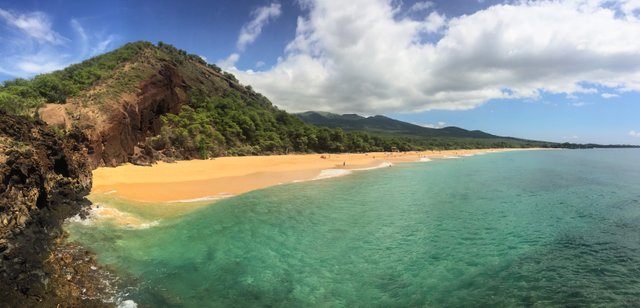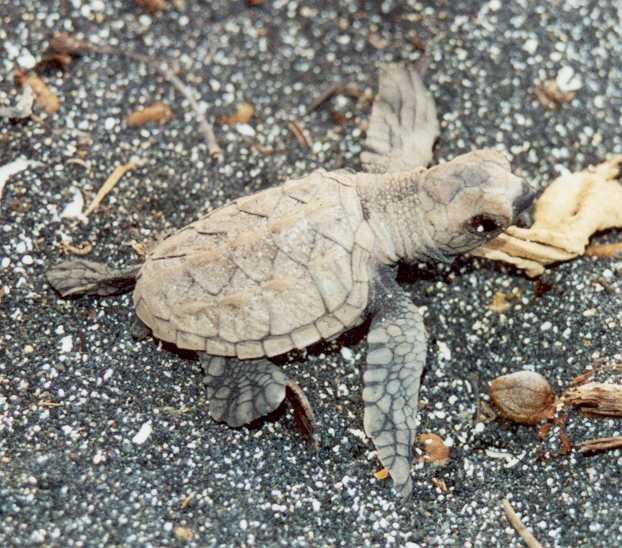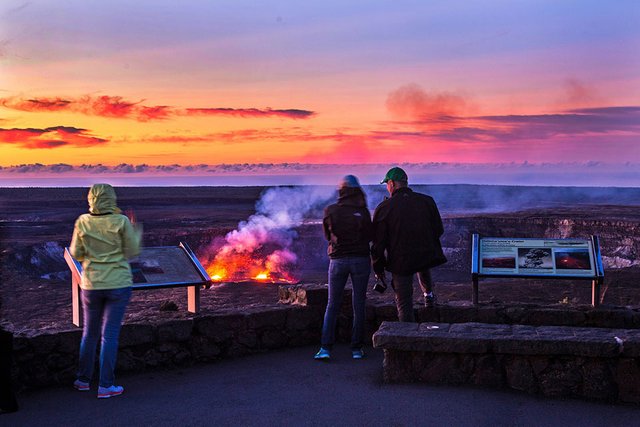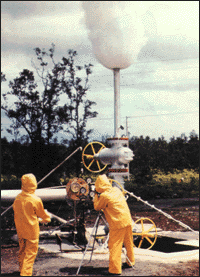Hawaiian volcanoes - Part 12: Benefits of Volcanoes
I have talked about the different sweeping hazards that arise form volcanoes. Nevertheless, every coin has two sides. And volcanoes have a good side to them as well. This is the reason why nearly 200,000 people are living on an active volcano in the middle of the ocean. In this post I quickly want to introduce a few of these benefits.
The Existence of the Islands themselves
This is the first, and probably very obvious, benefit. The volcanic activity in the center of the Pacific Ocean is the only cause the islands exist. It led to the evolution of majestic volcanic mountains and beautiful beaches.

Hawaii Maui Makena Big Beach.
commons.wikimedia.org
Oasis of Flora and Fauna
The Islands of Hawaii are a sanctuary for plants and animals alike, due to their tropical climate and their remote location in the middle of the ocean. Many believe that. Many believe that the Galápagos Islands are the best example for the amazing display of exotic natural selection. This is hardly surprising, given that Charles Darwin used this island to develop his Theory of Evolution. But on Hawai’i, evolution apparently has put on even greater show. On the Islands, thousands of different species of animals thrive, that can be found nowhere else on the planet. And life is not only flourishing on the emerged islands, but the habitats that the submerged atolls and coral reefs that volcanoes form in their later stages of life form are an equal if not greater oasis for life.
My reading has only scraped this topic, so if anyone were able to write a nice article about it I would really love reading it.

Hawksbill turtle hatching on the beaches of Hawai’i.
nps.gov
Beautiful national parks
The beautiful Hawaiian landscape combined with the pleasant climate has made the islands popular tourist destinations. Two of the most visited destinations are the two national parks.
Haleakalā National Park on Maui was founded in 1961. It encircles an area around the summit crater of the, 3000 m high, Haleakalā Volcano. This volcano has last been active in the 15th and 16th century.
The second one is Hawai’i Volcanoes National Park, which was established in 1916. It includes the two active volcanoes on the Big Island, Mauna Loa and Kīlauea. The park is one of the few places on the planet where geologists and non-geologists alike can view the processes and products involving active volcanism. Here, millions of people got the incredible opportunity to first hand experience the sight, sound, and smell generated by these magnificent features.

Jagger Museum observation deck in the Hawai’i Volcanoes National Park. Lava lake within Halema’uma’u Crater in the back.
nps.gov
Fertility of volcanic material
Lava flows are destructive forces, destroying nearly everything in their way. But given enough rainfall, new lava is recovered quickly. Vegetation begins to claim its place as shortly as one year after an eruption. The erosion of the volcanic material is creating fertile soils over the period of tens of thousands of years. These rich soils nurtured the agricultural development of the Hawaiian Islands. This development is represented by the large sugar, pineapple, coffee, and macadamia nut industries.
Pineapple field on Hawai’i, 1958.
commons.wikimedia.org
Source for building material
Some of the areas on the Hawaiian Islands provide an abundant local source of raw materials used in construction. They vary from landscaping, housing and construction, to road building.
Geothermal energy
Recently the State of Hawaii is receiving energy from a geothermal power plant that has been installed at Kīlauea’s east rift zone. 30 megawatts of electricity are produced and fed into the grid of the local utility company.
Unfortunately the use of Kīlauea’s geothermal potential has spawn protests from Hawaiian residents, especially the people living near the power plant. This is why, for the moment, new building projects are halted, until environmental and cultural concerns can be fully met.

Pressure testing on a geothermal well drilled into Kīlaueas east rift zone.
pubs.usgs.gov
Conclusion
All in all there are a lot of benefits that come with volcanic activity. Volcanic materials erode into incredibly fertile soils, rich in mineral nutrients. Thriving vegetation makes home for an incredible variety of animal life, that were able to live on the islands undisturbed. This has also led to humans thriving on these island when they arrived on them. Nowadays they promote agricultural growth, create intense tourism due to its beautiful landscape and might in the future deliver clean energy to the islands.
Previous Posts
Hawaiian volcanoes - Part 1: Introduction
Hawaiian volcanoes - Part 2: The Hawaiian Hotspot
Hawaiian volcanoes - Part 3: A growing volcano
Hawaiian volcanoes - Part 4: The Rejuvenation Stage
Hawaiian volcanoes - Part 5: Evolution to Atolls and Seamounts
Hawaiian volcanoes - Part 6: Mythology vs Geology
Hawaiian volcanoes - Part 7: Recent eruptions
Hawaiian volcanoes - Part 8: Volcano Monitoring
Hawaiian volcanoes - Part 9: Predicting Eruptions
Hawaiian volcanoes - Part 10: Volcanic Air Pollution
Hawaiian volcanoes - Part 11: Volcanoes falling apart… from Landslides and Tsunamis
References
- Tilling, R.I., Heliker, C., and Swanson D.A., (2010). Eruptions of Hawaiian volcanoes - past, present, and future: U.S. Geological Survey General Information Product 117, 63 p.
- http://www.bbc.com/earth/story/20150625-islands-where-evolution-ran-riot
- https://cleantechnica.com/2012/04/28/hawaii-residents-raise-serious-concerns-about-pgv-geothermal-energys-clean-energy-credentials/
- https://www.hawaiianelectric.com/clean-energy-hawaii/clean-energy-facts/renewable-energy-sources/geothermal
- https://www.nps.gov/hale/index.htm
- http://volcanology.geol.ucsb.edu/soil.htm
- https://commons.wikimedia.org/wiki/File:Hawaii_Maui_Makena_Big_Beach_(22649774315).jpg
- https://www.nps.gov/havo/learn/news/honuea14.htm
- https://www.nps.gov/havo/learn/news/20161130_pr_2017feefree.htm
- https://commons.wikimedia.org/wiki/File:Pineapple_field,_Hawaii,_1958.JPg
- https://pubs.usgs.gov/gip/hawaii/page50.html
Like an every natural thing, volcanos are more useful that dangerous. And the knowledge of fact that all ocean islands exist thank to volcanos, lead me to rapture from them!
Thank you for information!
Glad that you like it :)
Great post @sooflauschig - I really like learning about volcanoes. What about the contributions volcanoes provide in regards to the atmosphere?
I like being able to breathe and volcanoes do an excellent job of getting us all of the gases that make up our atmosphere. Thanks again!
Hawaii does seem like the ideal place to use standard geothermal. Do you know the main concerns of the protesters? Nice article!
It is a great place to harness geothermal energy and I hope they manage to one day run plants properly. In places like Hawaii, geothermal energy is the most cost efficient way to create energy.
But apparently the current power plant was horribly run. Open venting of geothermal gases and liquids dripped toxic materials into the environment. They had extremely poor environmental monitoring in general. Whole thing got swept under the rug. From corporate lies to disregard to hear residents requests. The compant who runs the plant lost all trust.
So the residents are beyond pissed at the moment, which is understandable. And until a respectful installment and operation of future plants cannot be guaranteed, there will be some trouble.
Another ongoing discussion is the proper use of Pele's power. Is it to be left alone and respected, or is it to be seen as a gift from Pele that should be harnessed. In the traditional Hawaiian way of thinking the use of geothermal energy is not supported. This belief stems from the idea that as long as Pele’s back is hot and she is active, her energy should not be used or manipulated.
Congratulations @sooflauschig! You have completed some achievement on Steemit and have been rewarded with new badge(s) :
Click on any badge to view your own Board of Honor on SteemitBoard.
To support your work, I also upvoted your post!
For more information about SteemitBoard, click here
If you no longer want to receive notifications, reply to this comment with the word
STOPYou received a 80.0% upvote since you are a member of geopolis and wrote in the category of "geopolis".
To read more about us and what we do, click here.
https://steemit.com/geopolis/@geopolis/geopolis-the-community-for-global-sciences-update-4
Interesting read, @sooflauschig! I already knew that volcanic soil was very rich in nutrients, but I had no idea that stuff could grow on it as early as a year from the eruption. That's a lot sooner then I anticipated!
Ōhi‘a lehua is found almost everywhere in native Hawaiian ecosystems and is the signature tree of the native forest. It can grow as little shrubs or grow to tall 30 m high trees. It is an incredible adaptor and usually the first one to start growing on recent lava flows.
commons.wikimedia.org